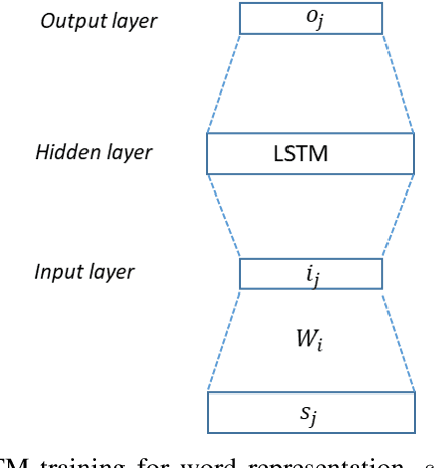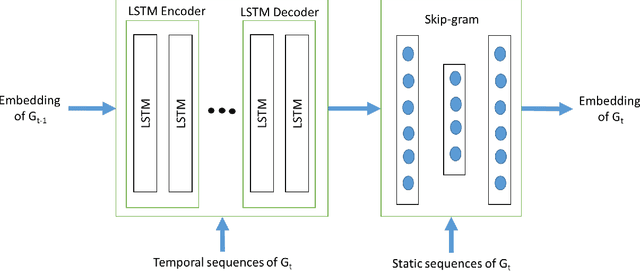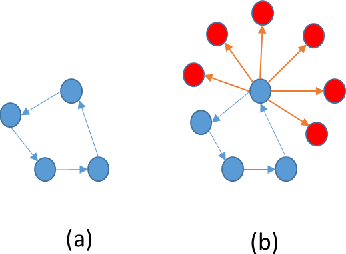Shima Khoshraftar
A Survey on Graph Representation Learning Methods
Apr 04, 2022



Abstract:Graphs representation learning has been a very active research area in recent years. The goal of graph representation learning is to generate graph representation vectors that capture the structure and features of large graphs accurately. This is especially important because the quality of the graph representation vectors will affect the performance of these vectors in downstream tasks such as node classification, link prediction and anomaly detection. Many techniques are proposed for generating effective graph representation vectors. Two of the most prevalent categories of graph representation learning are graph embedding methods without using graph neural nets (GNN), which we denote as non-GNN based graph embedding methods, and graph neural nets (GNN) based methods. Non-GNN graph embedding methods are based on techniques such as random walks, temporal point processes and neural network learning methods. GNN-based methods, on the other hand, are the application of deep learning on graph data. In this survey, we provide an overview of these two categories and cover the current state-of-the-art methods for both static and dynamic graphs. Finally, we explore some open and ongoing research directions for future work.
Dynamic Graph Embedding via LSTM History Tracking
Nov 05, 2019



Abstract:Many real world networks are very large and constantly change over time. These dynamic networks exist in various domains such as social networks, traffic networks and biological interactions. To handle large dynamic networks in downstream applications such as link prediction and anomaly detection, it is essential for such networks to be transferred into a low dimensional space. Recently, network embedding, a technique that converts a large graph into a low-dimensional representation, has become increasingly popular due to its strength in preserving the structure of a network. Efficient dynamic network embedding, however, has not yet been fully explored. In this paper, we present a dynamic network embedding method that integrates the history of nodes over time into the current state of nodes. The key contribution of our work is 1) generating dynamic network embedding by combining both dynamic and static node information 2) tracking history of neighbors of nodes using LSTM 3) significantly decreasing the time and memory by training an autoencoder LSTM model using temporal walks rather than adjacency matrices of graphs which are the common practice. We evaluate our method in multiple applications such as anomaly detection, link prediction and node classification in datasets from various domains.
Dynamic Joint Variational Graph Autoencoders
Oct 04, 2019



Abstract:Learning network representations is a fundamental task for many graph applications such as link prediction, node classification, graph clustering, and graph visualization. Many real-world networks are interpreted as dynamic networks and evolve over time. Most existing graph embedding algorithms were developed for static graphs mainly and cannot capture the evolution of a large dynamic network. In this paper, we propose Dynamic joint Variational Graph Autoencoders (Dyn-VGAE) that can learn both local structures and temporal evolutionary patterns in a dynamic network. Dyn-VGAE provides a joint learning framework for computing temporal representations of all graph snapshots simultaneously. Each auto-encoder embeds a graph snapshot based on its local structure and can also learn temporal dependencies by collaborating with other autoencoders. We conduct experimental studies on dynamic real-world graph datasets and the results demonstrate the effectiveness of the proposed method.
dynnode2vec: Scalable Dynamic Network Embedding
Dec 06, 2018



Abstract:Network representation learning in low dimensional vector space has attracted considerable attention in both academic and industrial domains. Most real-world networks are dynamic with addition/deletion of nodes and edges. The existing graph embedding methods are designed for static networks and they cannot capture evolving patterns in a large dynamic network. In this paper, we propose a dynamic embedding method, dynnode2vec, based on the well-known graph embedding method node2vec. Node2vec is a random walk based embedding method for static networks. Applying static network embedding in dynamic settings has two crucial problems: 1) Generating random walks for every time step is time consuming 2) Embedding vector spaces in each timestamp are different. In order to tackle these challenges, dynnode2vec uses evolving random walks and initializes the current graph embedding with previous embedding vectors. We demonstrate the advantages of the proposed dynamic network embedding by conducting empirical evaluations on several large dynamic network datasets.
 Add to Chrome
Add to Chrome Add to Firefox
Add to Firefox Add to Edge
Add to Edge